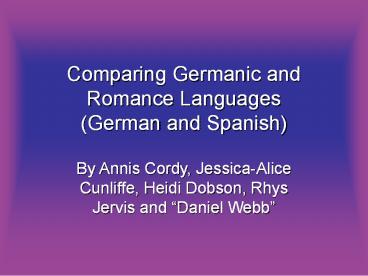Comparing Germanic and Romance Languages (German and Spanish) - PowerPoint PPT Presentation
Title:
Comparing Germanic and Romance Languages (German and Spanish)
Description:
... it was influenced by the Visigothic language (an East Germanic Language) ... we can conclude that some similarities lie within the East Germanic origins of ... – PowerPoint PPT presentation
Number of Views:771
Avg rating:3.0/5.0
Title: Comparing Germanic and Romance Languages (German and Spanish)
1
Comparing Germanic and Romance Languages(German
and Spanish)
- By Annis Cordy, Jessica-Alice Cunliffe, Heidi
Dobson, Rhys Jervis and Daniel Webb
2
Spanish Where is it spoken?
- The language is spoken by between 322 and 400
million people natively - This includes people from countries such as
Argentina, Bolivia, Chile, Colombia, Costa Rica,
Cuba, Dominican Republic, Ecuador, Equatorial
Guinea, El Salvador, Guatemala, Honduras, Mexico,
Nicaragua, Panama, Paraguay, Peru, Puerto Rico,
Spain, Uruguay, Venezuela
3
Where Is German Spoken?
- German is the tenth most widely spoken language
in the world, with a total of 123,527,178
speakers worldwide. The countries in which it is
a native language include not only Germany and
Austria, but also Switzerland (4.6 million
speakers) and Liechtenstein (32,000 speakers).
Other countries where it has official status as a
widely spoken language are Luxemburg, Italy and
Belgium. Smaller German speaking communities also
exist in North and South America, South Africa
and Australia.
4
Variations of Spanish
- Me gusta ver la tele. (I like to watch the
television) - Due to massive emigration from Andalusia to the
Spanish colonies in the Americas and elsewhere,
many American Spanish dialects share some
fundamental characteristics with Andalusian
Spanish, such as the use of ustedes instead of
vosotros for the second person plural, and the
widespread use of seseo.
5
Variations Of German
English Hochdeutsch Austrian
In the morning Am Morgen In der Früh
Noodles Die Spätzle Das Nockerl
Whipped cream Die Schlagsahne Das Obers
A German person disparaging term Deutsche Der Piefke
6
The Origins of the Spanish Language
- Although Spanish is a romance language it was
influenced by the Visigothic language (an East
Germanic Language). - It also has Arabic influence dating from 711 CE.
- Shortly before the arrival of Christopher
Columbus to the Americans, Spanish settlers were
introduced to a host of native languages and
adopted a number of words from them.
7
The Origins of the German Language
- Proto-Germanic
- / I \
- West Germanic North Germanic East Germanic
- / \ I / \
- Anglo-Frisian Netherlandic German W.Scandinavian
E.Scandinavian I Gothic - / \ / \ / I \ / \
- English Frisian Netherlandic German Icelandic
Faroese Norwegian Danish Swedish
8
Word Order and Translation
- I like it
- Ich mag das I like that
- Me gusta Me it pleases
9
- I have a yellow house
- Ich habe ein gelbes Haus
- I have a yellow house
- Tengo una casa amarilla
- I have a house yellow
10
- I go to London because I like shopping
- Ich fahre nach London, weil ich einkaufen mag
- I travel to London because I to shop like
- Voy a Londres porque me gusta ir de compras
- I go to London because me it pleases to go of
purchases
11
- I can see him
- Ich kann ihn sehen
- I can him to see
- Puedo verlo
- I can to see him
12
I have eaten it
- Ich habe es gegessen
- I have it eaten
- Lo he comido
- It I have eaten
13
Similarities between German and Spanish
English Spanish German
Hammock amacca Hängematte
14
Spanish Phonology
15
German Phonology
16
Conclusion
- After making these comparisons, we can conclude
that some similarities lie within the East
Germanic origins of both languages, although the
impact of these on the languages particularly
Spanish- could be seen as negligible. The
differences between the languages outweigh the
similarities, which would explain why they belong
to different language families. - There are, however, several Germanically-derived
words in Spanish which correspond quite closely
to words in modern Hochdeutsch, for example - East. In Spanish oeste, in German Ost
- Soup. In Spanish sopa, in German Suppe.
- Mascot. In Spanish mascota, in German
Maskotte. - However, it is debatable whether these words have
the same Germanic origins, or are simply just
derived or loaned from another language such as
English.
17
Special Thanks to Daniel Webb for Speech Coaching
and Therapy, and also for stroking Jess
German researchers Jess Cunliffe and Annis Cordy
Spanish researchers Heidi Dobson and Rhys Jervis
Thanks for listening































